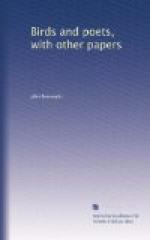XIV
Notwithstanding what I have elsewhere said about the desolation of snow, when one looks closely it is little more than a thin veil after all, and takes and repeats the form of whatever it covers. Every path through the fields is just as plain as before. On every hand the ground sends tokens, and the curves and slopes are not of the snow, but of the earth beneath. In like manner the rankest vegetation hides the ground less than we think. Looking across a wide valley in the month of July, I have noted that the fields, except the meadows, had a ruddy tinge, and that corn, which near at hand seemed to completely envelop the soil, at that distance gave only a slight shade of green. The color of the ground everywhere predominated, and I doubt not that, if we could see the earth from a point sufficiently removed, as from the moon, its ruddy hue, like that of Mars, would alone be visible.
What is a man but a miniature earth, with many disguises in the way of manners, possessions, dissemblances? Yet through all—through all the work of his hands and all the thoughts of his mind—how surely the ground quality of him, the fundamental hue, whether it be this or that, makes itself felt and is alone important!
XV
Men follow their noses, it is said. I have wondered why the Greek did not follow his nose in architecture,—did not copy those arches that spring from it as from a pier, and support his brow,—but always and everywhere used the post and the lintel. There was something in that face that has never reappeared in the human countenance. I am thinking especially of that straight, strong profile. Is it really godlike, or is this impression the result of association? But any suggestion or reminiscence of it in the modern face at once gives one the idea of strength. It is a face strong in the loins, or it suggests a high, elastic instep. It is the face of order and proportion. Those arches are the symbols of law and self-control. The point of greatest interest is the union of the nose with the brow,—that strong, high embankment; it makes the bridge from the ideal to the real sure and easy. All the Greek’s ideas passed readily into form. In the modern face the arches are more or less crushed, and the nose is severed from the brow,—hence the abstract and the analytic; hence the preponderance of the speculative intellect over creative power.
XVI
I have thought that the boy is the only true lover of Nature, and that we, who make such a dead set at studying and admiring her, come very wide of the mark. “The nonchalance of a boy who is sure of his dinner,” says our Emerson, “is the healthy attitude of humanity.” The boy is a part of Nature; he is as indifferent, as careless, as vagrant as she. He browses, he digs, he hunts, he climbs, he halloes, he feeds on roots and greens and mast. He uses things roughly and without sentiment. The coolness with which boys will drown dogs or cats, or hang them to trees, or murder young birds, or torture frogs or squirrels, is like Nature’s own mercilessness.




